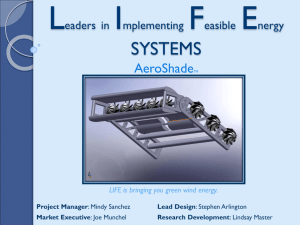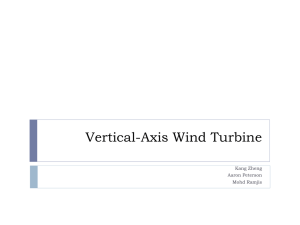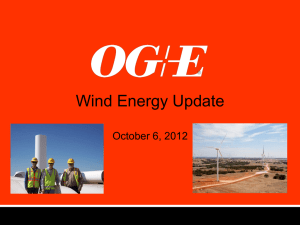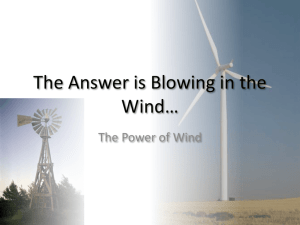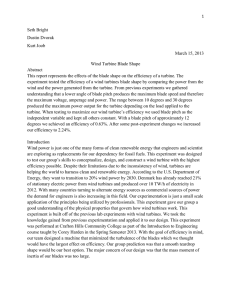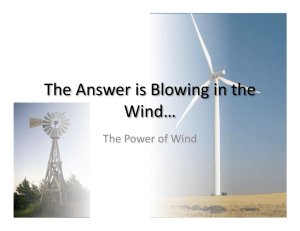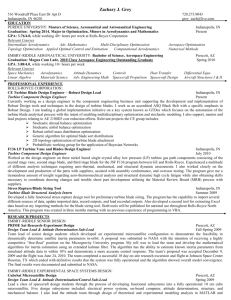IMETI_VAWT - Georgia Institute of Technology
advertisement
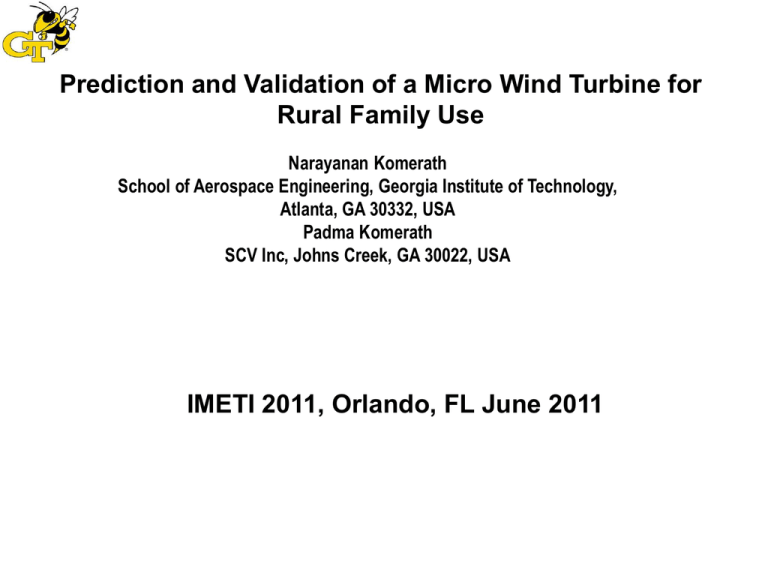
Prediction and Validation of a Micro Wind Turbine for Rural Family Use Narayanan Komerath School of Aerospace Engineering, Georgia Institute of Technology, Atlanta, GA 30332, USA Padma Komerath SCV Inc, Johns Creek, GA 30022, USA IMETI 2011, Orlando, FL June 2011 ACKNOWLEDGEMENTS The work reported in this paper was made possible by resources being developed for the “EXTROVERT” cross-disciplinary learning project under NASA Grant NNX09AF67G S01. Mr. Anthony Springer is the Technical Monitor. Points Made A simple self-starting vertical axis turbine design has been demonstrated. Figure of merit of small vertical axis wind turbines is low. Measured power levels are low, but these are justified by the cost of alternatives at these low power levels. Double-bladed turbine design is effective where blade cost is low. Flexible-blade designs are fairly effective for the 1m turbine in the 100 watt regime, but are inadequate for a 2m version of the design at any power level, due to flutter issues. Momentum and Blade element theory predictions show that high rotational speeds are required to obtain good figure of merit where the turbine radius is small. Need high solidity to bring optimal tip speed ratio down. Outline •Design philosophy, requirements and constraints: Inexpensive blades suitable for cottage industry Rotating parts from bicycles. Development steps: • construction, static testing measurement of performance. •Numerical simulation issues. •Moderate success with 1m diameter, 1 meter tall turbine using inexpensive and commonly available materials and construction techniques •Yawed biplane blade design with Savonius and Darreus features. •A 2m x 2m design scaled up from the 1meter machine; Failure with flexible design. •New design with stronger blade construction being developed. Initial Bicycle Wind Turbine Concept 4-Arm 1m VAWT with straight cambered-vane double blades and guidevane starter. 3-Arm 2m VAWT with straight cambered-vane double blades and Savonius starter. Yawed bi-blade 1m self-starting vertical axis wind turbine: PVC pipe construction Static Test Results:Choice of CPVC pipe vs. PVC pipe and wooden rod for main blade spar Centrifuge effect on blades Strobe-lit snapshot of the 3-armed VAWT in operation. Blue guidevane visible to the left. Steel tube/ wooden rib/foam/fiberglass/ blades for 1KW turbine 54-inch Horizontal Axis Wind Turbine Electrical Output vs. Wind Speed, with 50 Ohm resistive load (2 tests) Aspect Ratio Effect on Optimal Tip Speed Ratio Blade element predictions of the mechanical power output of the 3-armed, bibladed VAWT, for different choices of blade chord compared to the baseline chord, with fixed span Measured VAWT mechanical power in two tests vs. preliminary predictions from momentum streamtube theory. Conclusions The philosophy behind the design of small, low-cost vertical axis wind turbines for family use is explained, and leads to a design where blades are inexpensive and the rotating parts come from bicycles. The measured power levels are low, but these are justified by the cost of alternatives at these low power levels. Specific conclusions: 1. The figure of merit of small vertical axis wind turbines is low. 2. A double-bladed turbine design is effective where blade cost is low. 3. Flexible-blade designs are fairly effective for the 1m turbine in the 100 watt regime, but are inadequate for a 2m version of the design at any power level, due to flutter issues. 4. Blade element theoretical predictions of the power show that high rotational speeds are required to obtain good figure of merit where the turbine radius is small. 5. A simple self-starting vertical axis turbine design has been demonstrated.
